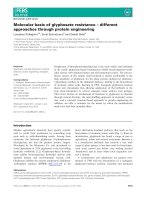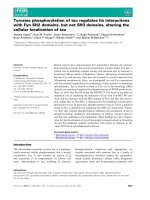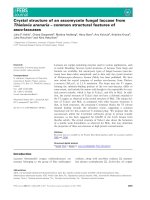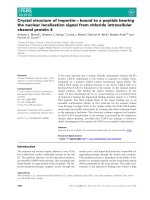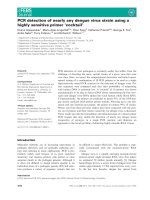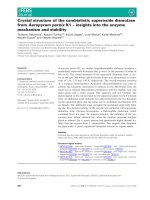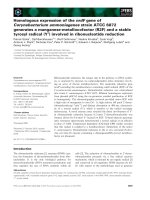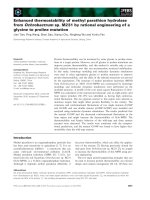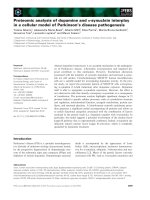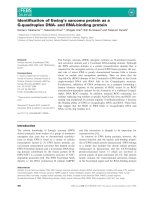Báo cáo khoa học: Translational incorporation of L-3,4-dihydroxyphenylalanine into proteins docx
Bạn đang xem bản rút gọn của tài liệu. Xem và tải ngay bản đầy đủ của tài liệu tại đây (361.97 KB, 10 trang )
Translational incorporation of L-3,4-dihydroxyphenylalanine
into proteins
Kiyoshi Ozawa
1
, Madeleine J. Headlam
1
, Dmitri Mouradov
2
, Stephen J. Watt
3
, Jennifer L. Beck
3
,
Kenneth J. Rodgers
4
, Roger T. Dean
5
, Thomas Huber
2
, Gottfried Otting
1
and Nicholas E. Dixon
1
1 Research School of Chemistry, Australian National University, Canberra, Australia
2 Departments of Biochemistry and Mathematics, University of Queensland, St. Lucia, Australia
3 Department of Chemistry, University of Wollongong, Australia
4 The Heart Research Institute, Sydney, Australia
5 The University of Canberra, Australia
The incorporation of non-natural amino acids opens up
the possibility to endow proteins with properties that
cannot be attained with the 20 natural amino acids
encoded by DNA base triplets. The incorporation of
non-natural amino acids can readily be achieved with
the natural protein-translational machinery, if the struc-
ture of the modified amino acid is closely related to the
natural amino acid, so that it can be loaded onto tRNA
by one of the natural aminoacyl-tRNA synthetases.
A wide range of non-natural amino acids has been
incorporated into proteins in this way [1]. In general,
the efficiency of incorporation decreases with increasing
K
M
value of the aminoacyl-tRNA synthetase for the
respective amino acid. This holds, in particular, for the
in vivo incorporation of non-natural amino acids, where
a pool of natural amino acids is always present. This
problem can be circumvented by the use of auxotrophic
strains [1] or cell-free protein production systems
derived from nonauxotrophic strains combined with a
suitably manipulated medium for protein synthesis [2,3].
Recently, high-yield, cell-free protein production
systems have become available that allow the synthesis
of proteins in quantities sufficient for structural geno-
mics applications [4–7]. High-level incorporation of
seleno-methionine (Se-Met) for X-ray crystallography
and fluoro-tryptophan (F-Trp) for NMR has been
Keywords
cell-free protein synthesis; DOPA; protein
oxidation; protein NMR; protein misfolding
Correspondence
N. E. Dixon, Research School of Chemistry,
Australian National University, Canberra,
ACT 0200, Australia
Fax: +61 2 612 50750
Tel: +61 2 612 54391
E-mail:
(Received 16 February 2005, revised 2 April
2005, accepted 25 April 2005)
doi:10.1111/j.1742-4658.2005.04735.x
An Escherichia coli cell-free transcription ⁄ translation system was used
to explore the high-level incorporation of l-3,4-dihydroxyphenylalanine
(DOPA) into proteins by replacing tyrosine with DOPA in the reaction
mixtures. ESI-MS showed specific incorporation of DOPA in place of tyro-
sine. More than 90% DOPA incorporation at each tyrosine site was
achieved, allowing the recording of clean
15
N-HSQC NMR spectra.
A redox-staining method specific for DOPA was shown to provide a sensi-
tive and generally applicable method for assessing the cell-free production
of proteins. Of four proteins produced in soluble form in the presence of
tyrosine, two resulted in insoluble aggregates in the presence of high levels
of DOPA. DOPA has been found in human proteins, often in association
with various disease states that implicate protein aggregation and ⁄ or mis-
folding. Our results suggest that misfolded and aggregated proteins may
result, in principle, from ribosome-mediated misincorporation of intracellu-
lar DOPA accumulated due to oxidative stress. High-yield cell-free protein
expression systems are uniquely suited to obtain rapid information on solu-
bility and aggregation of nascent polypeptide chains.
Abbreviations
DOPA,
L-3,4-dihydroxyphenylalanine; GFP, cycle 3 mutant green fluorescent protein; hCypA, human cyclophilin A; His
6
-PpiB, N-terminal His
6
-
tagged PpiB; HMP, Escherichia coli flavohaemoglobin; HSQC, heteronuclear single-quantum coherence; NBT, nitroblue tetrazolium; PpiB,
E. coli peptidyl-prolyl cis-trans isomerase B; RNAP, RNA polymerase; TyrRS, tyrosyl-tRNA synthetase.
3162 FEBS Journal 272 (2005) 3162–3171 ª 2005 FEBS
demonstrated [8,9], but limited dilution of isotope-
labelled with unlabelled natural amino acids has also
been reported [6].
This study investigated the high-level, high-yield
incorporation of l-3,4-dihydroxyphenylalanine (DOPA)
into proteins by replacing tyrosine with DOPA in the
reaction mixture of an Escherichia coli cell-free tran-
scription ⁄ translation system. The K
M
value for E. coli
tyrosyl-tRNA synthetase (TyrRS) was reported to be
200-fold higher for l-DOPA than for l-tyrosine
(1.4 mm vs. 6 lm) [10,11], i.e. the natural enzyme dis-
criminates against DOPA one order of magnitude more
strongly than the respective aminoacyl tRNA synthe-
tases incorporating Se-Met vs. Met [12] and F-Trp vs.
Trp [13]. DOPA-enrichment is advantageous as it allows
the facile assessment of protein production levels,
because a highly specific staining method is available
[14]. Finally, DOPA is produced naturally in humans by
tyrosinase-catalysed oxidation of tyrosine in melano-
cytes for melanin production, and by tyrosine hydroxy-
lase in the brain for biosynthesis of catecholamine
neurotransmitters [15].
In addition, the accumulation of protein-bound
DOPA in cells and tissues is a feature of a number of
pathologies associated with ageing, such as atheroscler-
osis [15] and cataractogenesis [16], where it derives at
least in part from oxygen-radical mediated post-trans-
lational oxidation of tyrosine side chains in proteins
[15]. It has recently been shown that DOPA can be
incorporated directly from the medium into proteins in
cultured mouse [16] and human [17] cells, and that
incorporation relies on protein synthesis [16]. If trans-
lational (ribosome-mediated) incorporation of DOPA
is a distinct possibility, the structural and functional
consequences of DOPA incorporation would be
important to assess.
This study used a preparative E. coli cell-free tran-
scription ⁄ translation system [5,18] to incorporate
DOPA into four different in vitro-synthesized proteins.
MS and NMR spectroscopy were used to verify whe-
ther DOPA incorporation occurred at positions nor-
mally occupied by tyrosine, and to assess the level of
DOPA incorporation. The effects on folding of the
four proteins (all of which have known structures)
were assessed by examination of their solubility follow-
ing their in vitro synthesis.
Results
Protein synthesis in the presence of DOPA
The effect of substitution of DOPA for tyrosine was
investigated in a preparative in vitro protein synthesis
system that employs an E. coli cell-free (S30) extract as
the source of ribosomes, aminoacyl-tRNA synthetases
and translation factors [5,18]. We chose to examine the
synthesis of four different proteins whose three-dimen-
sional structures are known from X-ray crystallographic
studies: the peptidyl-prolyl cis–trans isomerases E. coli
(PpiB; Protein Data Bank Accession no. 2NUL) [19]
and human cyclophilin A (hCypA; Protein Data Bank
Accession no. 2CPL) [20], the E. coli flavohaemoglobin
(HMP; Protein Data Bank Accession no. 1GVH) [21]
and the Aequorea victoria green fluorescent protein
(GFP; Protein Data Bank Accession no. 1EMA) [22].
The first two proteins had previously been shown to be
produced in good yield in the in vitro reaction
[5,6,18,23].
All four proteins were found to be synthesized to simi-
larly high levels in the presence of 1 mm tyrosine or
DOPA (Fig. 1A; data not shown for PpiB). Analysis
of the supernatant and pellet fractions by Coomassie
Brilliant Blue staining of a SDS ⁄ PAGE gel indicated
that all were soluble or mostly soluble when expressed
using tyrosine (Fig. 1A). Whereas PpiB (18 kDa) and
HMP (44 kDa) were still largely soluble when they were
synthesized with DOPA, > 50% of hCypA (18 kDa)
and GFP (27 kDa) were in the insoluble fraction. This
implies that incorporation of DOPA can interfere with
correct protein folding.
The yield of PpiB depended remarkably little on the
concentration of DOPA or tyrosine in the reaction
mixtures. High yields similar to those obtained with
1mm tyrosine or DOPA were obtained with either
amino acid at 50 lm (data not shown). With 10 and
5 lm DOPA, the yields were 20 and 50% lower,
respectively, than with 10 lm tyrosine, and there was
still discernible production of PpiB when both amino
acids were omitted. This is presumably because of the
presence of a trace of tyrosine as a contaminant in the
S30 extract or its biosynthesis during the reaction.
DOPA is incorporated into proteins during
cell-free synthesis
To show that DOPA was incorporated into the trans-
lated proteins, we first used a redox staining method
employing nitroblue tetrazolium (NBT), which detects
proteins containing o-catechols, like DOPA, after their
separation by SDS ⁄ PAGE and western transfer to
poly(vinylidene difluoride) membranes [14,17]. The
staining method was verified using purified His
6
-PpiB
that had been produced by cell-free synthesis in the pres-
ence of 0.05 or 1.0 mm DOPA or 1.0 mm tyrosine. The
protein was purified in similar yields from each reaction
(2 mg per 2 mL of reaction mixture) by metal-ion
K. Ozawa et al. Translational incorporation of DOPA into proteins
FEBS Journal 272 (2005) 3162–3171 ª 2005 FEBS 3163
affinity chromatography and analysed by duplicate
SDS ⁄ PAGE gels that were stained either with Coomas-
sie Brilliant Blue (Fig. 2A) or by redox staining
(Fig. 2B). Only His
6
-PpiB that had been produced in the
presence of DOPA stained with NBT, and the staining
intensity was somewhat higher for the sample produced
with 1.0 mm in comparison with 0.05 mm DOPA.
This staining method could also be used to detect
de novo synthesized proteins in the crude reaction mix-
tures. Proteins synthesized with tyrosine were not
stained by NBT, but those made in the presence of
DOPA were readily and specifically detected (Fig. 1B).
These results show the incorporation of DOPA during
cell-free protein synthesis. The sensitivity of this method
is comparable with staining by Coomassie Brilliant Blue,
and only newly synthesized proteins were detected,
including some minor species presumed to have been
produced by proteolysis and ⁄ or premature termination
of translation (Fig. 1B). It confirmed that high-level
DOPA incorporation results in mostly insoluble protein
in the cases of GFP and hCypA and mostly soluble pro-
tein for HMP and PpiB. Given that the chromophore in
GFP involves a tyrosine (Tyr66), and that its photo-
physical properties are particularly sensitive to substi-
tution of this residue [22,24,25], it was of interest to
examine fluorescence spectra of in vitro synthesized
GFP. The excitation and emission spectra of crude mix-
tures containing the fraction of soluble GFP that had
been produced with tyrosine or DOPA were found to be
identical. Nevertheless, the yield of fluorescence was
low (10–20%) in the soluble fraction from the
HMP
A
66
45
30
20
14
(kDa)
*
*
*
DOPA
RSPRSP RSP RSP RSP RSP
TYR DOPATYR DOPATYR
hCyPA GFP
B
*
*
*
RSPRSP RSP RSP RSP RSP
DOPA stain
protein stain
Fig. 1. Proteins are synthesized in good
yields in vitro using DOPA in place of tyro-
sine. Duplicate in vitro synthesis reactions
were carried out with 1 m
M tyrosine (TYR)
or with 1 m
M DOPA. Proteins in equal por-
tions of the complete reaction mixtures (R)
or the fractionated soluble (S) and pelleted
(P) fractions were separated by 15%
SDS ⁄ PAGE. Duplicate gels were stained
separately with Coomassie Brilliant Blue (A)
and NBT (B) as described in Experimental
procedures. The mobility of molecular mass
marker proteins (sizes in kDa) were as indi-
cated, and positions of newly synthesized
full-length proteins are marked by asterisks.
66
45
31
21
14
97
7
PpiB
86
43
33
19
7
TYR
0.05 1.0 1.0
TYR
0.05 1.0 (mM) 1.0
DOPA DOPA
DOPA stain
AB
protein stain
(kDa)
Fig. 2. DOPA incorporated into His
6
-PpiB during its in vitro synthe-
sis can be detected by redox staining. His
6
-PpiB was isolated by
Ni
2+
-affinity chromatography from reaction mixtures containing
1m
M tyrosine (TYR) or 0.05 or 1 mM DOPA, as indicated. Approxi-
mately equal amounts (12.5 lg) of each of the purified protein sam-
ples were separated on duplicate 15% SDS ⁄ PAGE gels, which
were stained with Colloidal Coomassie protein stain (A) or with
NBT (B) as described in Experimental procedures. Mobilities of
marker proteins (sizes in kDa; prestained in B) were as indicated.
Translational incorporation of DOPA into proteins K. Ozawa et al.
3164 FEBS Journal 272 (2005) 3162–3171 ª 2005 FEBS
DOPA sample compared with that prepared with tyro-
sine (data not shown). This indicates that although some
portion of GFP was capable of folding correctly into a
soluble form when DOPA was incorporated in place of
Tyr66, the chromophore either did not form or was
not appreciably fluorescent. The insoluble fraction was
not noticeably fluorescent.
Having shown that DOPA could be translationally
incorporated into various proteins, we next established
that this occurred specifically in place of tyrosine. This
was done in three ways: (a) by showing that the mass
of intact purified DOPA–His
6
-PpiB, as determined by
ESI-MS under native conditions, was increased by 16
mass units per tyrosine residue; (b) by showing that a
relative increase in mass of tryptic fragments from
DOPA–His
6
-PpiB, as determined by ESI-MS after
separation by RP-HPLC was observed only for pep-
tides that would otherwise contain tyrosine and (c)
that NMR chemical shift changes for samples of selec-
tively
15
N-labelled DOPA–PpiB relative to native
15
N-labelled PpiB were consistent with the specific
incorporation of DOPA in place of tyrosine.
ESI-MS of DOPA-labelled His
6
-PpiB
The mass of purified His
6
-PpiB produced in the pres-
ence of 0.05 mm DOPA was compared with that of
the normal protein produced with 1.0 mm tyrosine.
Two species were present in the tyrosine sample in
almost equal proportions, with M
r
values of 19 221.7
and 19 249.7 (Fig. 3A, peaks A and B, respectively).
The larger component corresponds to a form of the
protein that retains the N-formyl group on the N-ter-
minal methionine residue (calculated M
r
19 249.6), and
the smaller is the mature protein produced after
deformylation (calculated M
r
19 221.6). This is in
accord with the results of a previous NMR study, in
which amide resonances could be observed for the
N-terminal methionine as well as for the following
residue in hCypA [18], indicating that our S30 extract
is deficient in peptide deformylase activity [6].
His
6
-PpiB contains three tyrosine residues. When
produced with DOPA, the protein contained several
species (Fig. 3B). The most abundant had masses of
19 297.9 (peak G), 19 281.9 (peak F) and 19 269.3
(peak E), in order of decreasing intensity. These spe-
cies correspond to the N-formylated protein with three
and two, and deformylated protein with three DOPA
residues, respectively. Semiquantitative assessment of
the incorporation level of DOPA was made by com-
parison of the sum of the peak heights of the 3-DOPA
species (peaks E, G, H and I) vs. the sum of the peak
heights of the 2-DOPA species (peaks D and F). This
ratio was found to be 3 : 1. The same ratio was found
by comparing the peak heights of peaks E (2-DOPA
species) and D (1-DOPA species). This suggests that
about three-quarters of all tyrosine residues had been
replaced by DOPA, corresponding to an incorporation
level of > 90% at each of the three tyrosine sites. The
less than 100% efficiency was presumably due to traces
of tyrosine (and ⁄ or tyrosyl-tRNA) remaining in, or
synthesized by, the cell-free extract.
HPLC–ESI-MS of tryptic peptides from
DOPA-labelled His
6
-PpiB
Peptides resulting from partial tryptic digestion of
His
6
-PpiB that had been produced using 1 mm tyro-
sine or 1 mm DOPA were separated by HPLC and
Mass (Da)
19200 19300 19400
Relative intensity
A
B
TYR
DOPA
(A)
C
H
G
F
E
D
AB
I
A: 19221.7 – 3 Tyr
B: 19249.7 – formyl + 3 Tyr
C: 19238.4 – 1 DOPA
D: 19254.0 – 2 DOPA
E: 19269.3 – 3 DOPA
F: 19281.9 – formyl + 2 DOPA
G: 19297.9 – formyl + 3 DOPA
H: 19320.0 – formyl + 3 DOPA + Na
I: 19338.2 – formyl + 3 DOPA + K
Fig. 3. Positive-ion ESI-MS analysis of in vitro synthesized His
6
-
PpiB. Samples of His
6
-PpiB isolated by Ni
2+
-affinity chromatography
from reaction mixtures containing 1 m
M tyrosine (A) or 0.05 mM
DOPA (B) were analysed by ESI-MS in 10 mM ammonium acet-
ate ⁄ formic acid (pH 3.0). Peaks in the transformed spectra are indica-
ted, and their observed masses and compositions are indicated in
the key shown below. Weak peaks in the spectra at higher masses
are presumed to be adducts resulting from the presence of small
amounts of sodium and potassium ions in the protein samples.
K. Ozawa et al. Translational incorporation of DOPA into proteins
FEBS Journal 272 (2005) 3162–3171 ª 2005 FEBS 3165
analysed by in-line ESI-MS. Peptides of M
r
> 500
(the threshold for ESI-MS), identified by correspon-
dence between their M
r
values and amino acid compo-
sition, spanned 165 (96%) of 172 residues of the
amino acid sequence (Table 1). For both samples, a
significant portion of the N-terminal peptides had a
mass 28.0 units higher than expected; this confirms
that the additional mass seen for much of the in vitro
synthesized intact His
6
-PpiB (Fig. 3B) is due to retent-
ion of the formyl group on the N-terminal methionine
residue (see above) [6,18].
Three tryptic peptides, each containing one of the
three tyrosine residues in His
6
-PpiB, were observed at
the expected mass in both samples. In the sample pre-
pared with DOPA, three additional, more-abundant,
peptides were observed, each with masses 16.0 units
higher than these three (Table 1), as might be expected
if each of the tyrosine residues was substantially
replaced by DOPA. No peptides were observed that
might correspond to significant replacement of another
amino acid residue by DOPA.
NMR analysis of DOPA-labelled (
15
N)PpiB
In a previous study [18], we showed that crude reac-
tion mixtures containing hCypA produced in vitro in
the presence of
15
N-labelled amino acids could be used
directly, after dialysis into an NMR buffer (phosphate,
pH 6.5), to record residue-specific
15
N-HSQC NMR
spectra. The protein remained soluble during and fol-
lowing dialysis [18]. In contrast, in this study, the ini-
tially soluble portion of DOPA–hCypA precipitated
quantitatively on dialysis into the NMR buffer, which
indicates that incorporation of DOPA destabilizes the
native structure of hCypA.
Therefore, the E. coli homologue of hCypA, PpiB,
was used for NMR studies. We recorded
15
N-HSQC
NMR spectra of crude mixtures containing PpiB that
had been synthesized in the presence of tyrosine or
DOPA using amino acid mixtures that contained
both (
15
N)cysteine and (
15
N)phenylalanine in place of
the corresponding unlabelled amino acids, and then
dialysed into an NMR buffer (Fig. 4A). The buffer
was identical to that used previously during assign-
ment of the amide
15
N-
1
H resonances in PpiB [23],
and the availability of those data permitted the imme-
diate assignment of most of the cysteine and phenyl-
alanine amide resonances in the spectra of Fig. 4A.
The protein samples were all completely soluble dur-
ing their preparation, indicating that incorporation of
DOPA did not irreversibly disrupt the structure of
PpiB.
Table 1. ESI-MS tryptic peptide fingerprint of His
6
-PpiB synthesized in the presence of tyrosine or DOPA. The His
6
-PpiB used in these
experiments contains, in addition to the wild-type PpiB sequence, an N-terminal Met-(His)
6
tag and an additional Asn residue at the C termi-
nus. f-M, N-formyl-methionine. #, DOPA residue. Peptides containing DOPA are indicated in bold.
Observed mass (Da)
Theoretical
mass (Da)
Amino
acids Sequence
Tyrosine L-DOPA
2592.5 2592.5 2593.2 1–21 f-MHHHHHHMVTFHTNHGDIVIK
2565.5 2565.6 2565.2 1–21 MHHHHHHMVTFHTNHGDIVIK
3825.9 3825.9 3824.8 1–32 f–MHHHHHHMVTFHTNHGDIVIKTFDDKAPETVK
3797.9 3797.9 3796.8 1–32 MHHHHHHMVTFHTNHGDIVIKTFDDKAPETVK
1250.7 1251.5 1250.6 22–32 TFDDKAPETVK
2178.9 2178.0 22–39 TFDDKAPETVKNFLD#CR
2162.9 2162.9 2162.0 22–39 TFDDKAPETVKNFLDYCR
946.4 946.4 33–39 NFLD#CR
930.4 930.4 930.4 33–39 NFLDYCR
1413.7 1413.7 40–50 EGF#NNTIFHR
1397.5 1396.7 1397.7 40–50 EGFYNNTIFHR
1781.6 1781.6 1781.9 51–67 VINGFMIQGGGFEPGMK
1627.0 1627.8 1626.9 70–84 ATKEPIKNEANNGLK
1326.5 1326.6 1326.7 73–84 EPIKNEANNGLK
719.4 719.4 719.4 88–94 GTLAMAR
5285.0 5283.4 95–142 TQAPHSATAQFFINVVDNDFLNFS-
GESLQGWG#CVFAEVVDGMDVVDK
5269.0 5269.0 5267.4 95–142 TQAPHSATAQFFINVVDNDFLNFS-
GESLQGWGYCVFAEVVDGMDVVDK
561.4 561.4 560.3 145–150 GVATGR
2413.7 2414.0 2413.2 151–172 SGMHQDVPKEDVIIESVTVSEN
Translational incorporation of DOPA into proteins K. Ozawa et al.
3166 FEBS Journal 272 (2005) 3162–3171 ª 2005 FEBS
PpiB contains 2 cysteine and 12 phenylalanine resi-
dues. The
15
N-HSQC spectrum of the DOPA–PpiB
sample showed only the resonances expected for a sin-
gle set of 14
15
N-labelled residues, most of which were
shifted relative to the signals of the tyrosine–PpiB sam-
ple. The remarkably homogeneous appearance of the
15
N-HSQC spectrum of the
15
N-labelled DOPA–PpiB
sample could only be explained by uniform and
> 90% incorporation of DOPA in place of any of the
three tyrosines. The signal-to-noise ratio in the spec-
trum was insufficient to observe signals at the 10%
level.
Figure 5 shows that the phenylalanine and cysteine
residues are quite uniformly distributed in the three-
dimensional structure of PpiB, generating a range of
minimum distances with respect to the three tyrosine
side chains. The introduction of additional hydroxyl
groups resulting from replacement of tyrosine by
DOPA changes the chemical environment and can
thus, potentially, affect the chemical shifts of the pro-
tons in the immediate vicinity of the hydroxyl groups,
whereas the chemical-shift changes of protons far from
the DOPA side chains are always expected to be small.
As expected, amide protons located far from the near-
est C
e
atom of the tyrosine side chains in the three-
dimensional structure of PpiB produced, at most, small
changes in chemical shifts, and the largest changes in
chemical shifts were observed for amide protons close
to a DOPA side chain (Fig. 4B).
Discussion
At the outset of this study it was not clear that the
cell-free synthetic reaction would produce good yields
of proteins when DOPA was provided in place of tyro-
sine, nor whether they would be produced in a soluble
and therefore native folded state. Purified E. coli
TyrRS is capable of charging tRNA (presumably
tRNA
Tyr
) with DOPA in vitro [10,11] with a similar
turnover number for l-tyrosine and DOPA, but a
much higher value of K
M
for DOPA [10]. Compared
with the K
M
values of the respective aminoacyl tRNA
synthetases acting on Se-Met ⁄ Met or F-Trp ⁄ Trp pairs,
the K
M
value of TyrRS for the DOPA ⁄ Tyr pair is an
order of magnitude less favourable for the non-natural
amino acid [12,13]. It is thus remarkable [1] that highly
efficient DOPA incorporation could be achieved using
an S30 extract from a nonauxotrophic E. coli strain,
and without significantly reduced protein yields
(Fig. 1). The DOPA incorporation level of > 90%
achieved at each tyrosine site compares favourably
with a recent report, in which the cell-free incorpor-
ation of isotope-labelled tyrosine resulted in dilution
with 3% unlabelled tyrosine [6]. Although the level
of DOPA incorporation was sufficiently high to record
a clean
15
N-HSQC spectrum, signals from incompletely
DOPA-enriched protein molecules at the 10% level
could interfere with the interpretation of weak NOESY
cross-peaks. If desired, the incorporation level could
F99
F55
F4
F110
F16
F41
F35
F27
F123
F98
F48
F107
C31
C121
110
115
120
125
130
δ1( N) / ppm
15
δ2( H) / ppm
1
7910 8
A
B
distance from nearest Tyr C / Å
ε
0 15105
∆δ / Hz
150
100
50
0
Fig. 4. Effect of incorporation of DOPA on the
15
N-HSQC NMR
spectrum of crude reaction mixtures containing selectively
15
N-labelled PpiB. (A) PpiB was synthesized in reaction mixtures
containing (
15
N)cysteine and (
15
N)phenylalanine (each at 0.35 mM)
in place of unlabelled cysteine and phenylalanine, with either 1 m
M
tyrosine (peaks in black and highlighted with boxes) or 1 mM DOPA
(in red). The amide resonances were assigned to the two cysteine
and 12 phenylalanine residues of wild-type PpiB as shown [23]. (B)
Correlation between amide chemical shift changes induced by
DOPA and the distance from tyrosine side chains in the structure
of PpiB. The chemical shift changes between DOPA-substituted
and native PpiB are reported here as Dd ¼ ([Dd(
1
H)]
2
+
[Dd(
15
N)]
2
)
1 ⁄ 2
, calculated using values of Dd(
1
H) and Dd(
15
N) meas-
ured in Hz at 600 MHz
1
H NMR frequency. The distances were
measured as the shortest distance between the respective amide
protons to any of the C
e1
or C
e2
carbon atoms of a tyrosine residue
in the crystal structure of PpiB (Protein Data Bank Accession no.
2NUL) [19] (Fig. 5). Arrows label the data points of the amide pro-
tons of Phe16 and Phe41 which overlap in the NMR spectra of
wild-type and DOPA–PpiB. For one of these residues, the chemical
shift change would be smaller than indicated. That all data points
fall below the dashed line is consistent with expectations for sub-
stitution of DOPA at tyrosine residues in the protein.
K. Ozawa et al. Translational incorporation of DOPA into proteins
FEBS Journal 272 (2005) 3162–3171 ª 2005 FEBS 3167
probably be increased further by deriving the S30
extract from an E. coli strain that is auxotrophic for
tyrosine. The N-terminal heterogeneity arising from
incomplete deformylation did not result in any peak-
doubling in the
15
N-HSQC spectrum, presumably
because the nearest
15
N-labelled amide group was
located > 9 A
˚
from the N-terminus (Fig. 5).
This study further demonstrates that the presence of
DOPA in newly synthesized proteins can easily be
detected using a sensitive redox-staining procedure that
detects catechols like DOPA [14,17]. Synthesis in the
presence of DOPA and redox staining thus offers a
convenient alternative to the use of antibodies or
radiolabelled amino acids for the specific detection and
quantification of in vitro-synthesized proteins. The
residual fluorescence observed in the soluble fraction
of DOPA-enriched GFP suggests that functional pro-
teins can still be obtained in the presence of DOPA,
provided that not all of the tyrosine residues are
replaced.
MS (Fig. 3 and Table 1) and NMR (Fig. 4) data
with PpiB produced by this route showed that DOPA
is incorporated exclusively in place of tyrosine. This is
consistent with our previous studies using mammalian
cells in culture, which demonstrated that [
14
C]DOPA
competed with tyrosine for incorporation into cell pro-
teins [16,17]. The current data strongly suggest that
DOPA is loaded onto tRNA
Tyr
by TyrRS and incor-
porated into proteins during their translational synthe-
sis in E. coli in complete analogy to tyrosine.
Cell-free protein synthesis turns out to provide a fast
route for the qualitative detection of the formation of
protein aggregates, as insoluble proteins form visible
precipitates already during protein synthesis. Two of
the four proteins examined (hCypA and GFP) were
seen to be largely insoluble when produced in vitro
with DOPA, but were soluble when produced with
tyrosine (Fig. 1). Because incorporation of DOPA was
not 100% efficient, this suggests that proteins were
incapable of correct folding when certain structurally
important tyrosine residues were substituted. GFP, for
example, contains nine tyrosines besides the one
(Tyr66) in the fluorophore, two of which (Tyr92 and
Tyr106) are completely buried in the structure.
hCypA and PpiB are highly homologous proteins
that contain two and three tyrosine residues, respect-
ively. One of these is at a conserved position and is
buried completely, whereas the others are closer to the
protein surface and are partially exposed to solvent.
Whereas DOPA–PpiB remained soluble, DOPA–
hCypA was found in the insoluble fraction. The
greater tolerance of PpiB towards the incorporation of
DOPA may be explained by the fact that, when com-
paring the natural proteins, hCypA is more prone to
precipitation. Remarkably, DOPA was also incorpo-
rated into HMP without apparent effects on its solu-
bility. The ortho positions of 8 of the 12 tyrosine rings
in the apo form of HMP are solvent-exposed and can
readily accommodate the extra hydroxyl group of
DOPA.
We conclude that unless the DOPA side chains are
solvent exposed, the translational incorporation of
DOPA into proteins can affect their ability to fold in a
native (soluble) structure, leading to misfolded ⁄ aggre-
gated forms. This observation has additional import-
ance in the context of oxidative damage and disease.
We have recently shown that DOPA can be incorpor-
ated from the medium into mammalian cells in tissue
Fig. 5. Stereoview of the X-ray crystal structure of wild-type E. coli PpiB. Amide protons of the 12 phenylalanine and two cysteine residues
are marked with spheres, and the side chains of the three tyrosine residues are highlighted in black. The following colour code is used for
the other amino acid side chains: hydrophobic residues (Ala, Cys, Ile, Leu, Met, Phe, Pro, Trp, Val), yellow; positively (Arg, His, Lys) and neg-
atively (Asp, Glu) charged residues, blue and red, respectively; hydrophilic residues (Asn, Gln, Ser, Thr), grey. The figure was prepared using
MOLMOL [31].
Translational incorporation of DOPA into proteins K. Ozawa et al.
3168 FEBS Journal 272 (2005) 3162–3171 ª 2005 FEBS
culture in a process that relies on de novo protein syn-
thesis [16,17]. It is known that DOPA in proteins can-
not be enzymatically repaired, yet it is redox active
and potentially capable of inflicting further damage on
biomolecules [15]. The presence of DOPA in misfolded
proteins associated with various disease states in
humans and animals is well established, and is
assumed to arise largely by postranslational oxidation
of tyrosine residues by oxygen free radicals [15].
Increased sensitivity to misfolding of newly translated
proteins due to DOPA incorporation during transla-
tion could present an additional route for detrimental
effects elicited by DOPA, aggravating the risks asso-
ciated with DOPA accumulation. Determination of the
ratio of K
M
values of human TyrRS for DOPA and
Tyr and measurement of intracellular DOPA concen-
trations will be required to substantiate the importance
of this pathway.
Experimental procedures
In vitro cell-free protein synthesis
For production of the E. coli flavohaemoglobin HMP [26],
transcription of the hmp gene was directed by tandem
phage k p
R
and p
L
promoters in plasmid pPL757 [27]. Plas-
mid derivatives of the T7-promoter vectors pETMCSI or
pETMCSIII [28] were used to programme in vitro synthesis
of hCypA (using pBH964) [18], PpiB (with and without an
N-terminal His
6
tag, using pND1098 and pKO1154,
respectively), and cycle 3 mutant GFP (using pMH1200).
Plasmids pND1098 (His
6
-PpiB) and pKO1154 (PpiB)
were constructed by insertion of the appropriate genes as
PCR-generated NdeI–EcoRI fragments between the corres-
ponding sites in pETMCSIII or pETMCSI, respectively. To
construct pMH1200 (GFP), a linker consisting of an equi-
molar mixture of oligonucleotides 683 (5¢-TATG
ACTAG
TAGCTAGGGATCCTAAG) and 684 (5¢-AATTCTTAG
GATCCCTAGCTACTAGTCA) was first inserted between
the NdeI and EcoRI sites of pETMCSI to generate the new
vector pETMCSIV (4670 bp) containing SpeI and BamHI
sites in its multiple cloning site (underlined in the sequences
above). The SpeI–BglII fragment from plasmid pLEIGwt
that encodes GFP was then inserted between these new sites
in pETMCSIV to generate pMH1200; pLEIGwt [29] was
a generous gift from Dr Peter Schultz (Scripps Research
Institute, La Jolla, CA, USA). The orientations of inserted
fragments and their integrity in the new plasmids were con-
firmed by nucleotide sequence determination (Biomolecular
Resource Facility, Australian National University). Proteins
were produced in the E. coli cell-free protein synthesis sys-
tem described previously [5,18], with some modifications as
described below. The concentrated S30 extract was pre-
pared from E. coli A19 (metB rna) cells as described else-
where [4]. Procedures for purification of phage T7 RNA
polymerase (RNAP) [18] and E. coli RNAP holoenzyme [5]
were as described.
The inner chamber reaction mixtures (usually 0.6–0.7 mL,
in a dialysis sac) contained 55 mm Hepes ⁄ KOH pH 7.5,
1.7 mm dithiothreitol, 1.2 mm ATP, 0.8 mm each of CTP,
UTP and GTP, 0.64 mm 3¢,5¢-cAMP, 68 lm folinic acid,
27.5 mm ammonium acetate, 208 mm potassium l-gluta-
mate, 80 mm creatine phosphate, 250 lgÆmL
)1
creatine kin-
ase, 1 mm each of the other 19 l-amino acids (unless
specified otherwise), 15 mm magnesium acetate, 175 lgÆmL
)1
of total E. coli tRNA, 0.05% NaN
3
, 210 unitÆmL
)1
RNase
inhibitor, 16 lgÆmL
)1
of supercoiled plasmid DNA, 24%
(v ⁄ v) of concentrated S30 extract (at 31 mgÆmL
)1
of total
protein), and either additional E. coli (155 lgÆmL
)1
)orT7
RNAP (93 lgÆmL
)1
), as required for transcription from k
p
R
p
L
or T7 promoters, respectively. The outer chamber
dialysis buffer had the same composition as the inner cham-
ber mixture, except that enzymes, tRNA and DNA were
omitted, and magnesium acetate was present at 19.3 mm.
To test whether DOPA was incorporated into newly syn-
thesized proteins, it was provided in place of tyrosine in
both reaction chambers. Protein synthesis was initiated by
the addition of plasmid DNA to the inner reaction cham-
ber, which was then immersed in the outer-chamber solu-
tion (12–14 mL) at 37 °C and shaken at 200 r.p.m. The
outer-chamber solution was changed twice during the 8–9 h
reaction [5,18]. Unless indicated otherwise, the products
were separated into soluble and insoluble fractions by cen-
trifugation at 30 000 g for 1 h at 4 °C. Soluble fractions
from crude reaction mixtures containing in vitro-synthesized
GFP were diluted 20-fold into 50 mm Hepes ⁄ KOH, pH 7.5
in a 3 mL cuvette, and fluorescence excitation and emission
spectra were recorded at room temperature with a Cary
Eclipse fluorescence spectrophotometer (Varian Inc., Palo
Alto, CA, USA).
SDS/PAGE analysis
The soluble and insoluble fractions were analysed by dupli-
cate 15% SDS ⁄ PAGE gels. One gel was stained with Coo-
massie Brilliant Blue for total protein detection. Proteins in
the other were transferred electrophoretically to poly(viny-
lidene difluoride) membrane and stained with NBT using a
redox cycling procedure for the detection of proteins that
contain DOPA [14].
Purification of in vitro synthesized His
6
-PpiB
Scaled-up in vitro cell-free reaction mixtures (2.0 mL) con-
taining His
6
-PpiB synthesized using either the complement
of natural amino acids or with DOPA (0.05 or 1 mm)
substituted for tyrosine were centrifuged at 100 000 g for
4 h at 4 °C to pellet ribosomes and ribosome-associated
K. Ozawa et al. Translational incorporation of DOPA into proteins
FEBS Journal 272 (2005) 3162–3171 ª 2005 FEBS 3169
proteins. The supernatant was mixed with an equal vol-
ume of Buffer P (20 mm sodium phosphate, pH 7.5, 0.5 m
NaCl, 1 mm 2-mercaptoethanol) containing 10 mm imida-
zole and applied to a column of Ni-NTA agarose (Qiagen,
Hilden, Germany; 1.5 · 1.8 cm) that had been equilibrated
with the same buffer. After a washing with Buffer P
+10 mm imidazole (10 mL), bound proteins were eluted
by sequential application of Buffer P containing 20, 100
and 500 mm imidazole (8 mL each). Fractions were ana-
lysed by 15% SDS ⁄ PAGE; those that contained highly
purified His
6
-PpiB were combined and concentrated to
1 mL by use of an Amicon (Billerica, MA, USA) Ultra-4
centrifugal concentrator (MWCO 10 000). The final
protein concentration was estimated using the Bradford
method [30] with bovine serum albumin as a standard.
Mass spectrometry
Samples of purified His
6
-PpiB that had been synthesized
in vitro with tyrosine or 0.05 or 1 mm DOPA were analysed
by MS in several ways. ESI-MS of the native proteins after
buffer exchange into 10 mm ammonium acetate, pH 6.8
and addition of formic acid to pH 3.0, were acquired with
a Micromass (Wyntheshawe, UK) Q-TOF2 spectrometer
operated in V-mode with a desolvation temperature of
180 °C, source temperature of 40 °C and cone voltage of
50 V. Ions from electrospray series were transformed to a
mass scale using masslynx
TM
software (Micromass).
To confirm that DOPA had been incorporated specifi-
cally in place of tyrosine, the masses of almost every tryptic
peptide from samples of purified His
6
-PpiB were deter-
mined. Protein samples ( 60 lg in 100 lLof10mm Hepes ⁄
KOH pH 7.5, 1 mm dithiothreitol) were digested with trypsin
(0.2 lg; 24 h at 37 °C), and peptides were separated by
RP-HPLC using a C
18
capillary column (Agilent Technolo-
gies, Palo Alto, CA, USA), eluted with a gradient of 0–60%
(v ⁄ v) acetonitrile in 0.1% aqueous acetic acid over 45 min at
a flow rate of 0.1 lLÆmin
)1
. The capillary column was con-
nected in-line to an Applied Biosystems QSTAR Pulsar mass
spectrometer, which was used to record ESI-MS. Theoretical
masses of peptides were calculated using the Expasy website
( To determine
the theoretical mass for proteins and peptides that contained
DOPA in place of tyrosine, 16.0 mass units were added for
each tyrosine residue.
NMR measurements
Samples of (untagged) PpiB containing either tyrosine or
DOPA were prepared by in vitro synthesis in 0.7 mL reac-
tions programmed with pKO1154, essentially as described
above with tyrosine or DOPA at 1 mm, except that
l-[
15
N]phenylalanine and l-[
15
N]cysteine (each at 0.35 mm,
Cambridge Isotope Laboratories, Andover, MA, USA)
were used instead of phenylalanine and cysteine [18]. The
inner-chamber mixtures containing
15
N-labelled PpiB were
dialysed overnight at 4 °C against 500 mL of an NMR buf-
fer comprised of 50 mm sodium phosphate (pH 6.2) and
1mm dithiothreitol, then clarified by centrifugation
(100 000 g, 4 h). The supernatants were concentrated to
about 0.6 mL using Amicon Ultra-4 centrifugal filters
(MWCO 10 000) and D
2
O was added to a final concentra-
tion of 10% before NMR measurements.
NMR spectra were recorded at 36 °C using a Varian
INOVA 600 MHz NMR spectrometer equipped with a
quadruple resonance (
1
H,
15
N,
13
C,
31
P) probe.
15
N-HSQC
spectra were recorded with 5 mm sample tubes using
t
1max
¼ 32 ms, t
2max
¼ 102 ms, and total recording times of
21 h.
Acknowledgements
We are grateful to Patrick Schaeffer for assistance with
plasmid construction. This work was supported by
grants from the National Health and Medical
Research Council of Australia (to R.T.D., K.R.) and
the Australian Research Council (to J.B., G.O., N.D.).
K.O. and G.O. acknowledge an Australian Linkage
(CSIRO) Postdoctoral Fellowship and a Federation
Fellowship, respectively.
References
1 Hendrickson TL, de Cre
´
cy-Lagard V & Schimmel P
(2004) Incorporation of non-natural amino acids into
proteins. Annu Rev Biochem 73, 147–176.
2 Budisa N (2003) Expression of ‘tailor-made’ proteins
via incorporation of synthetic amino acids by using cell-
free protein synthesis. In Cell-Free Protein Expression
(Swartz JR, ed.), 2nd edn, pp. 89–98. Springer-Verlag,
Berlin.
3 Sengupta K, Klammt C, Bernhard F & Ru
¨
terjans H
(2003) Incorporation of fluorescent labels into cell-free
produced proteins. Cell-Free Protein Expression (Swartz
JR, ed.), 2nd edn, pp. 81–88. Springer-Verlag, Berlin.
4 Kigawa T, Yabuki T, Yoshida Y, Tsutsui M, Ito Y,
Shibata T & Yokoyama S (1999) Cell-free production
and stable-isotope labeling of milligram quantities of
proteins. FEBS Lett 442, 15–19.
5 Guignard L, Ozawa K, Pursglove SE, Otting G &
Dixon NE (2002) NMR analysis of in vitro-synthesized
proteins without purification: a high-throughput
approach. FEBS Lett 524, 159–162.
6 Torizawa T, Shimizu M, Taoka M, Miyano H &
Kainosho M (2004) Efficient production of isotopically
labeled proteins by cell-free synthesis: a practical proto-
col. J Biomol NMR 30, 311–325.
7 Klammt C, Lohr F, Schafer B, Haase W, Dotsch V,
Ruterjans H, Glaubitz C & Bernhard F (2004) High
Translational incorporation of DOPA into proteins K. Ozawa et al.
3170 FEBS Journal 272 (2005) 3162–3171 ª 2005 FEBS
level cell-free expression and specific labeling of integral
membrane proteins. Eur J Biochem 271, 568–580.
8 Kigawa T, Yamaguchi-Nunokawa E, Kodama K,
Matsuda T, Yabuki T, Matsuda N, Ishitani R, Nureki
O & Yokoyama S (2001) Selenomethionine incorpora-
tion into a protein by cell-free synthesis. J Struct Funct
Genomics 2, 29–35.
9 Neerathilingam M, Greene LH, Colebrooke SA, Camp-
bell ID & Staunton D (2005) Quantitation of protein
expression in a cell-free system: efficient detection of
yields and
19
F NMR to identify folded protein. J Bio-
mol NMR 31, 11–19.
10 Calendar R & Berg P (1966) The catalytic properties of
tyrosyl ribonucleic acid synthetases from Escherichia coli
and Bacillus subtilis. Biochemistry 5, 1690–1695.
11 Ho
¨
genauer G, Kreil G & Bernheimer H (1978) Studies
on the binding of DOPA (3,4-dihydroxyphenylalanine)
to tRNA. FEBS Lett 88, 101–104.
12 Hoffman JL, McConnell KP & Carpenter DR (1970)
Aminoacylation of Escherichia coli methionine tRNA by
selenomethionine. Biochim Biophys Acta 199, 531–534.
13 Xu ZJ, Love ML, Ma LY, Blum M, Bronskill PM,
Bernstein J, Grey AA, Hofmann T, Camerman N &
Wong JT (1989) Tryptophanyl-tRNA synthetase from
Bacillus subtilis. Characterization and role of hydropho-
bicity in substrate recognition. J Biol Chem 264, 4304–
4311.
14 Paz MA, Fluckiger R, Boak A, Kagan HM & Gallop
PM (1991) Specific detection of quinoproteins by redox-
cycling staining. J Biol Chem 266, 689–692.
15 Rodgers KJ & Dean RT (2000) Metabolism of protein-
bound DOPA in mammals. Int J Biochem Cell Biol 32,
945–955.
16 Rodgers KJ, Wang H, Fu S & Dean RT (2002) Biosyn-
thetic incorporation of oxidized amino acids into pro-
teins and their cellular proteolysis. Free Radical Biol
Med 32, 766–775.
17 Rodgers KJ, Hume PM, Dunlop RA & Dean RT
(2004) Biosynthesis and turnover of DOPA-containing
proteins by human cells. Free Radical Biol Med 37,
1756–1764.
18 Ozawa K, Headlam MJ, Schaeffer PM, Henderson BR,
Dixon NE & Otting G (2004) Optimization of an
Escherichia coli system for cell-free synthesis of selec-
tively
15
N-labelled proteins for rapid analysis by NMR
spectroscopy. Eur J Biochem 271, 4084–4093.
19 Edwards KJ, Ollis DL & Dixon NE (1997) Crystal
structure of cytoplasmic Escherichia coli peptidyl-prolyl
isomerase: evidence for decreased mobility of loops
upon complexation. J Mol Biol 271, 258–265.
20 Ke H (1992) Similarities and differences between human
cyclophilin A and other b-barrel structures. Structural
refinement at 1.63 A
˚
resolution. J Mol Biol 228, 539–
550.
21 Ilari A, Bonamore A, Farina A, Johnson KA & Boffi A
(2002) The X-ray structure of ferric Escherichia coli fla-
vohemoglobin reveals an unexpected geometry of the
distal heme pocket. J Biol Chem 277, 23725–23732.
22 Ormo
¨
M, Cubitt AB, Kallio K, Gross LA, Tsien RY &
Remington SJ (1996) Crystal structure of the Aequorea
victoria green fluorescent protein. Science 273, 1392–
1395.
23 Kariya E, Ohki S-Y, Hayano T & Kainosho M (2000)
Backbone
1
H,
13
C, and
15
N resonance assignments of
an 18.2 kDa protein, E. coli peptidyl-prolyl cis–trans
isomerase b (EPPIb). J Biomol NMR 18, 75–76.
24 Tsien RY (1998) The green fluorescent protein. Annu
Rev Biochem 67, 509–544.
25 Zimmer M (2002) Green fluorescent protein (GFP):
applications, structure, and related photophysical
behavior. Chem Rev 102, 759–781.
26 Vasudevan SG, Armarego WLF, Shaw DC, Lilley PE,
Dixon NE & Poole RK (1991) Isolation and nucleotide
sequence of the hmp gene that encodes a haemoglobin-
like protein in Escherichia coli K-12. Mol Gen Genet
226, 49–58.
27 Love CA, Lilley PE & Dixon NE (1996) Stable high-
copy-number bacteriophage k promoter vectors for
overproduction of proteins in Escherichia coli. Gene 176,
49–53.
28 Neylon C, Brown SE, Kralicek AV, Miles CS, Love CA
& Dixon NE (2000) Interaction of the Escherichia coli
replication terminator protein (Tus) with DNA: a model
derived from DNA-binding studies of mutant proteins
by surface plasmon resonance. Biochemistry 39, 11989–
11999.
29 Wang L, Xie J, Deniz AA & Schultz PG (2003) Unna-
tural amino acid mutagenesis of green fluorescent pro-
tein. J Org Chem 68, 174–176.
30 Bradford MM (1976) A rapid and sensitive method for
the quantitation of microgram quantities of protein
utilizing the principle of protein–dye binding. Anal
Biochem 72, 248–254.
31 Koradi R, Billeter M & Wu
¨
thrich K (1996) MOLMOL:
a program for display and analysis of macromolecular
structures. J Mol Graph 14, 51–55.
K. Ozawa et al. Translational incorporation of DOPA into proteins
FEBS Journal 272 (2005) 3162–3171 ª 2005 FEBS 3171
